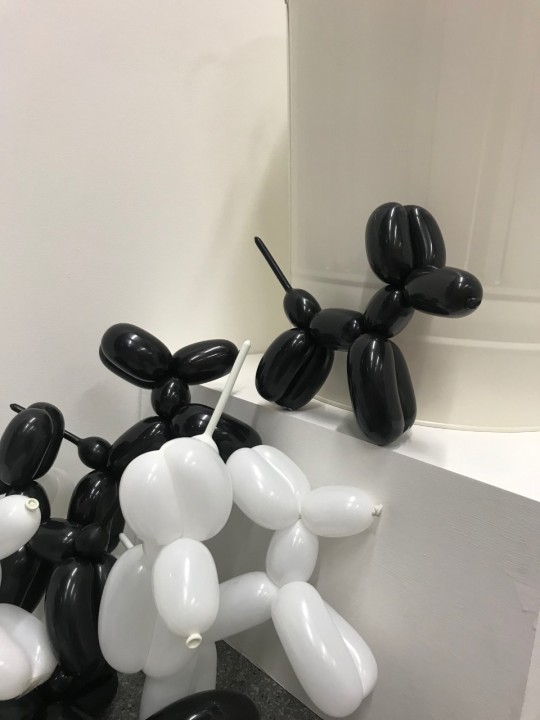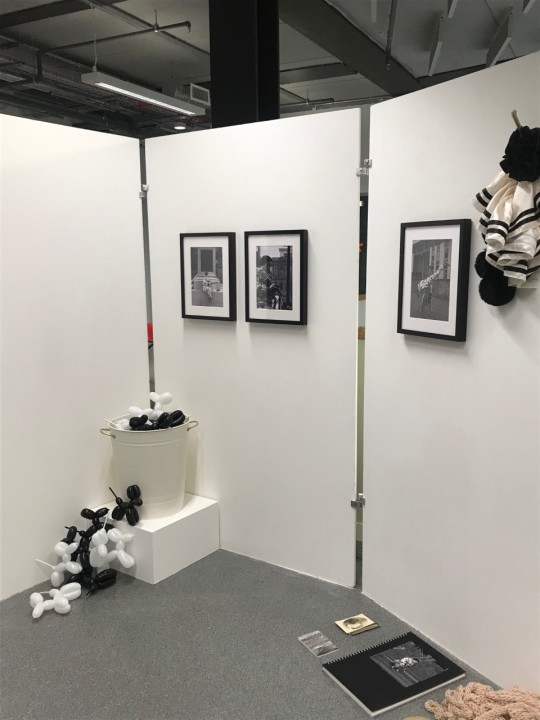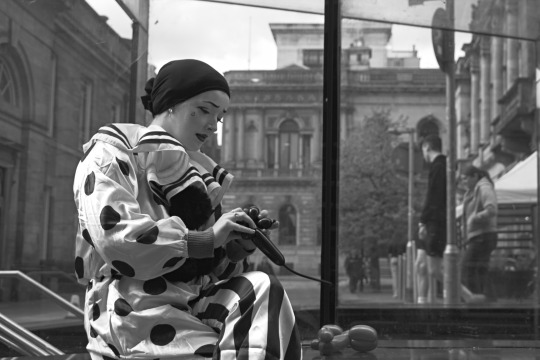Text
Maybe from as early as when you're five or six, there's been a whisper going at the back of your head, saying: “One day, maybe not so long from now, you'll get to know how it feels.” So you're waiting, even if you don't quite know it, waiting for the moment when you realise that you really are different to them; that there are people out there… who don't hate you or wish you any harm, but who nevertheless shudder at the very thought of you.
(Ishiguro, 2005)
My practice has often settled within the conceptual exploration of belonging. I am entrenched in what it means to belong, the pleasure of feeling loved, safe, and connected. This has developed into the natural exploration of its antonym, what it means to be rejected. The dichotomy of belonging and rejection is delicately balanced and symbiotic. The desire to belong is often fuelled by the fear of rejection, as referenced by Ishiguro, the realisation that we may inevitably be outcast or perceived as abnormal is innate and insidious. The human desire for connection with others can be a blessing when we are accepted, and a curse when rejected (DeWall, 2011), my belief is that this desire to belong can lead to inauthenticity fuelled by fear. However, the way to truly connect is to be authentic, even if we may be rejected for exposing our vulnerabilities. This risk/reward dynamic is the most conceptually intriguing aspect and evident in later developments. I began to consider what the ‘risk’ portion of presenting the authentic self is, for many the risk of rejection can lead to embarrassment, humiliation, or loneliness. Carragher (2017) articulates the universality of embarrassment and our relationship to it as artists;
We have all felt embarrassed and witnessed the embarrassment of others. It’s a universal emotion. It’s also a mainstay reality of the artistic process… this fear of embarrassment also indicates why most people who make art do so in the first place: the desire to connect with others. Artists present their work to an audience in hope and fear, even if that audience is small — or not yet existent.
(Carragher, 2017)
This is an integral aspect of my perspective, especially relating to rejection. By continually exposing our experiences and skillsets to a viewer with that possibility, artists can become desensitised to or comfortable with this potential for embarrassment within the context of their work.
Rejection can be fear-inducing because of its unpredictable nature. However, acknowledging embarrassment or standing out in a way which may court rejection in a controlled and autonomous way can override this fear. This is especially relevant when examining through feminist ideology like Fox’s Performance Art Can Change Your Life! (2019). Lack of control can exacerbate how unpleasant these feelings can be and the helplessness that arrives with them, as Klein references in his article The Humiliation Dynamic (2005). Klein also states that humiliation, and the fear of such, is detrimental to social development, but that ‘recognizing and acknowledging the… feeling of humiliation can be the key that opens the door to constructive dialogue.’ (Klein, 2005). To bypass the fear (the ‘risk’ of the risk/reward dynamic) of humiliation, negative emotions need to be acknowledged as inevitable. Acceptance of the reality that we will likely be outcast within life at some point (Ishiguro, 2005) removes the anxiety of the uncontrollable, thus rejection should not be tolerated as a barrier to expressing an authentic self. Joseph Campbell asserts that the ‘privilege of a lifetime is to become who you truly are’ (1995), underscoring the value of authenticity in the face of adversity. To be free of all anxieties is impossible, but to liberate oneself from societal and personal expectation can be done by accepting the true self, regardless of if it may be ostracised.
Another angle to this belonging/rejection relationship, and connection as reward for braving the risk, is detachment from the inebriated nature of childhood connection. The lack of understanding what being outcast truly means, leads children to connect freely and authentically and this freedom of expression dips as adolescents (Pickhardt, 2013). Rejection and humiliation exist to ‘engineer conformity in adults’ (Klein, 2005) and returning to a mindset where this conformity and need to belong no longer existed, only your own interests, affectations, and spontaneous wants matter, could also remove a barrier to expression and connection between us. David Sherry’s work is essential to my understanding when returning to free expression without expectation, especially regarding social connections (Sherry, n.d.).
These lines of enquiry led me to consider how to express these sentiments best. My natural focus on performative action led to progression. The nature and immediacy of performance, as well as the curiosity it invokes, dovetails well with the conceptual qualities of my practice. The spontaneity reflects the unpredictable nature of embarrassment, and the interest piqued through live art may help unlock the more childlike qualities I perceive as supportive of authentic expression. As discussed in The Radicality of Female Performance: How Feminist Works Catalysed Sociocultural Change and Influenced Contemporary Art Practice, 1960-1979 (2022), the medium holds a certain power in its immediacy and proximity to a viewer.
Performance art is utilised often when expressing the emotional and experimental lengths of human behaviour. Hayley Newman’s Crying Glasses (1995) provided inspiration when illustrating my conceptual path. The inclusion of public interaction, while at the same time not outwardly ‘performing’, just existing within a public space while expressing something out of the norm, became very encouraging. By remaining introspective and not explicitly encouraging participation from any serendipitous viewers, Newman allowed the public to consider and reflect on the passive action. Leaving my intent unexplained is anxiety-inducing, it invokes these feelings of insecurity and embarrassment which could be minimised. To perform in public and simply exist in any given ‘unusual’ state was a natural progression, in an informal setting there is no pretext, it is opening yourself to misconstructions or rejections of your intent.
Even when exaggerating a specific aspect of myself while performing, the work still exhibits my authentic being. I considered the intricacies within the concept and explored them as stages. My developments illustrate the path undertaken when healing the wound inside us that perceives belonging as a necessity, leading to acceptance of the inevitability of rejection, and empowerment that follows when embarrassment is self-authored. While my developments established different aesthetic qualities, the same conceptual thread is tightly adhered to. My initial experimentation revolved around this desperation to repress and involve aspects of others to camouflage. By taking from an ‘other’ (which may be perceived as external expectation) and imprinting on the self, the inauthentic self is created. While the concept of ourselves will constantly evolve and be influenced, the artificial attachment of other identities to our own leads to connection becoming shallow and anxiety-ridden. During this, I began questioning my secondary line of enquiry, the nature of recording performance excluding more conventional means. I imprinted in plaster the traces left behind. The results were far removed from the initial performative action but still captured an aspect of its spirit, stoking enquiry about where an object simply becomes sculpture and no longer documentation.
The next stage from anxious attachment to the ‘other’ was challenging expectations of self and fear of authentic expression. An intimate weaving of a prop was my way of incorporating the expectations of self, this prison would be entirely self-made – knitted with anxieties of perception. This is something to be free of, once wrapped tightly and then removed, much like the fear of embarrassment that may come with presenting a more genuine version of the self. This stage mimicked the one before with its dual outcomes, the performance itself and a sculptural object with involvement to the action. These pushed the documentation further, the plaster tablet is a object with a static impression while the weaved cords already invoke an action which must have been undertaken in a committed way to result in their production. The intention was that even if the object was the sole recording, a viewer could interpret the process undertaken to create it as a performance of its own.
The final stage is an assured self, autonomously choosing to undergo unpleasant feelings and shedding expectation, or simply apathetic to them, to express true authenticity. The public involvement is integral, but passive, the confidence displayed by partaking in my own tasks in an introspective way rather than interacting (the expectancies of clownery or entertainment) inverts expectations when I am so clearly placed to stand out. The dual purpose of object re-enters, both as a conceptual catalyst and a recording. The balloons are a gateway to encourage this unstifled childlike state, but also documentation of an action. The balloons inclusion in both the performance and my installation mimics the qualities of performance art as a medium, within the work they function as documentation of my movements. Within the installation, as a balloon is removed, the viewer has a representation of their connection to the work that will deflate and disappear much like the momentary nature of performance itself.
When regarding the feelings of embarrassment and humiliation and the concept of performing these feelings, my immediate thoughts were clownery. Clowns and jesters are exaggerated, with aesthetics which draw attention and dare people to look at them but often perform embarrassment for the sake of humour. I chose a Pierrot clown specifically for these final developments due to the deeper connotations they hold within theatre, of being downtrodden and hopeful of unrequited love, casting myself as someone who is rejected at every turn (Chandler, 2020). To cast oneself in this position harks back to anxieties surrounding perception, but this role of humiliation has been welcomed with open arms, so the fear is no longer a factor. There is no risk, only reward, when the authentic self is presented. The clown as a figure also connects to the childlike state, both within viewers and within the self where perception or rejection no longer matter. The character of a clown may be seen as artificial but as mentioned above, I find actions of performance as authentic and established as any other part of my identity. By becoming a clown, I also now belonged to a new group of women in costume (represented by found objects) rather than solely rejection by the majority, showing there is always an open pathway when presenting authentically.
To return to my original inspiration of belonging, I hope an affinity may be felt concerning my vulnerability while interpreting anxieties surrounding rejection, how to express myself authentically, and nurture genuine connections. The symbolic actions considered and undertaken will ideally influence others to introspect and consider the repercussions, or lack thereof, of liberating themselves from external expectation as well as the joy authentic expression brings.
0 notes
Text
Discussion and Justification of Aspects
The Balloons

The balloons as mentioned before have several purposes within the install, the first is to act as an object which suggests performative action. They are static, but even the visual denotes the twisting and blowing that must have happened to create them.
The second is connection to this childlike state before adolescence, where we do not fear rejection, we are often our more authentic selves. They also connect to the imagery of clowns and entertainment.
The third is an interactive element to the install. Viewers are welcome to take one with them but that is not explicitly stated anywhere. This lack of instruction but ambiguity surrounding the install allows people to make up their own mind on if its okay to nick one, again unlocking this ,mischievous childlike state.
Finally, the balloons act as a physical manifestation of the nature of performance themselves. They will deflate and flop and disappear back into a little bit of latex, nothing to denote their original shape, much like the momentary nature of performance. The temporary enjoyment of the balloon and the transient nature of performance mimic each other.
The Bin

The bin also serves dual purposes.
First it is something to physically gather the balloons within as a receptacle, and aesthetically the ivory and gold were painted to mirror the ivory in the collar and gold in the coat hook.
Secondly, it also hints at the temporary and passive nature of performance. The memories and intentions will fade and be discarded.
The Photographs


The photographs, as mentioned before, are a way to suggest a narrative and show evidence of a performance without spoonfeeding an audience.
They are mementos, little frozen moments. The frames infer they are precious, to be protected and revered in a way. Their importance is highlighted by their presentation. The idea of having three images in frames as a triptych both mimics the three parts of my development, and has strong visual impact.
The Coat Hook and Costume

The elements of the costume hanging and presented this way also serve a dual purpose.
They objects themselves are a recording of performance, they had a life with me creating these actions. The collar is also made with my own hands so could in a way be seen as soft sculpture.
The most important part of the way they are presented though is the inferration that a viewer may just take the costume off the hook and don it themselves. It poses a rhetorical question. If I can willingly expose myself to humiliation in the sake of overcoming fear of rejection, and create a more authentic version of myself, why can’t they? it allows a reflection on what fear is holding above peoples heads. The worst that happens is often people will laugh. But to be genuine to self and others, we must take the risk of rejection to understand the reward of true and authentic belonging.
0 notes
Photo

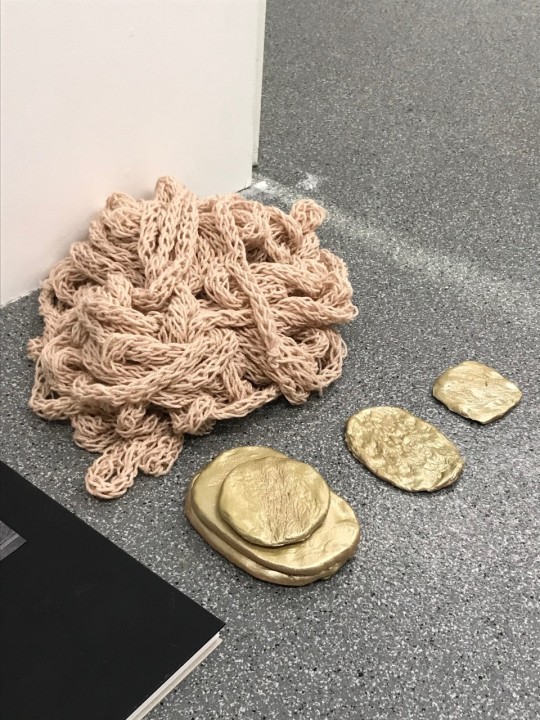
My physical traces of performance on display as development.
I actually really enjoy seeing all of my delicate little recordings side my side. The documentation has obviously been such an integral part of the work.
0 notes
Text
Development Books
As most of my work has been digital or video, I wanted to present physical work and see my intentions laid in front of me.
I created a small flipbook type softback, of my ‘assimilation’ performance images. a neat little collection of action.

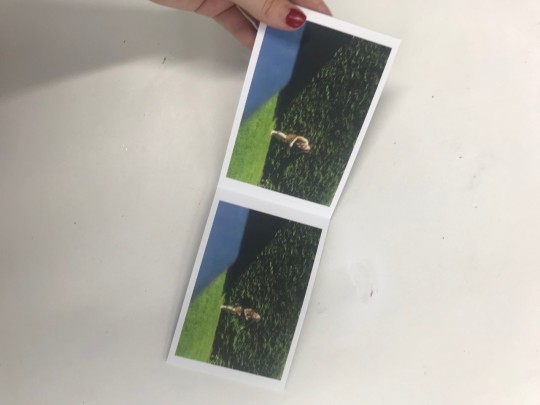

I also created a small photobook of my remaining black and white photos.

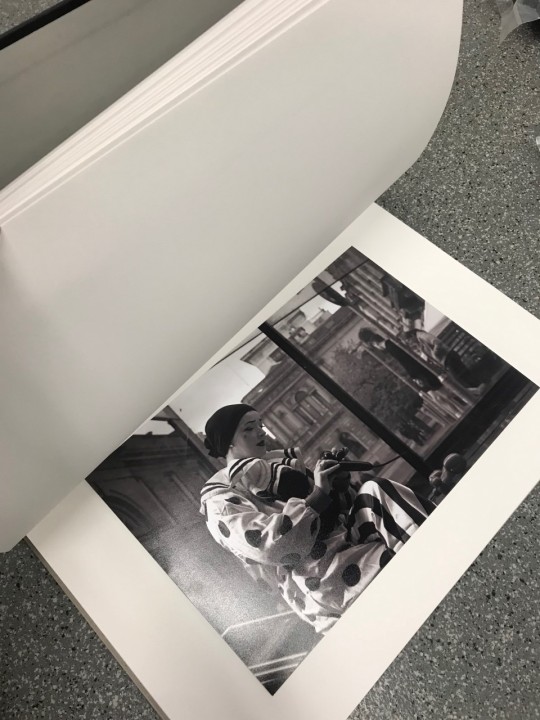
0 notes
Text
Diane Arbus
One of my biggest influences throughout the photography of my performance was Diane Arbus, in particular her ‘Untitled’ series of books and photographs.
This book captures residents at a home for those with additional needs, many of the images feature individuals in costume. There is an innocence and naivete to the images, they aren't regarded with sensationalism, simply existing.
I can draw parallels with my own work here. In my final works I did not outwardly perform, if anything I subverted expectations by being dressed as a clown but minding my own business theoretically, not entertaining others.
The visuals are beautiful and capture emotions somewhat undefinable and inebriated.
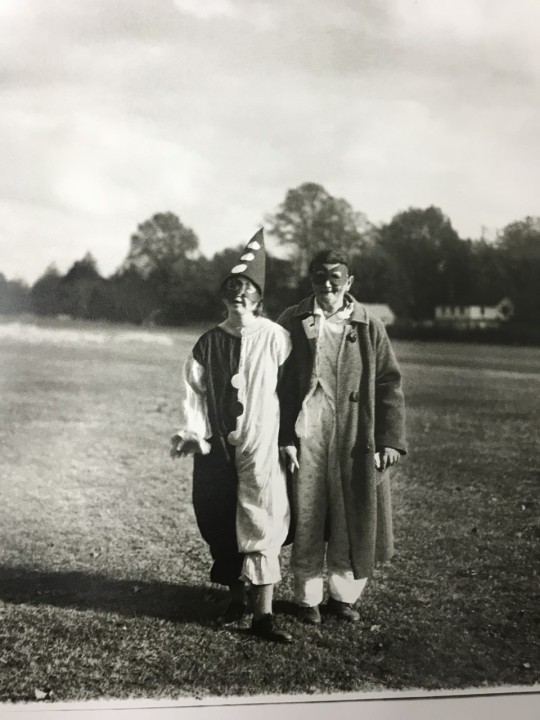

0 notes
Photo

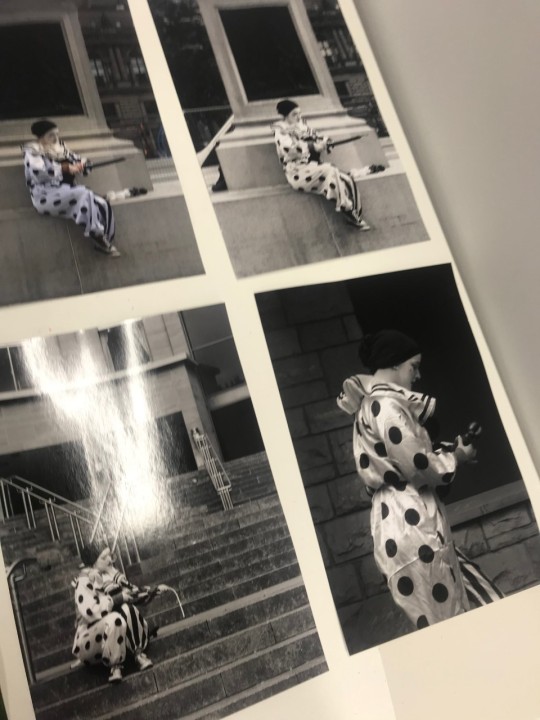



I chose to print quite a few of my performance images so I could have choice about which ones would go in the frames, balance together, and work with the space. The remainder which aren’t used will be presented as development work.
0 notes
Photo

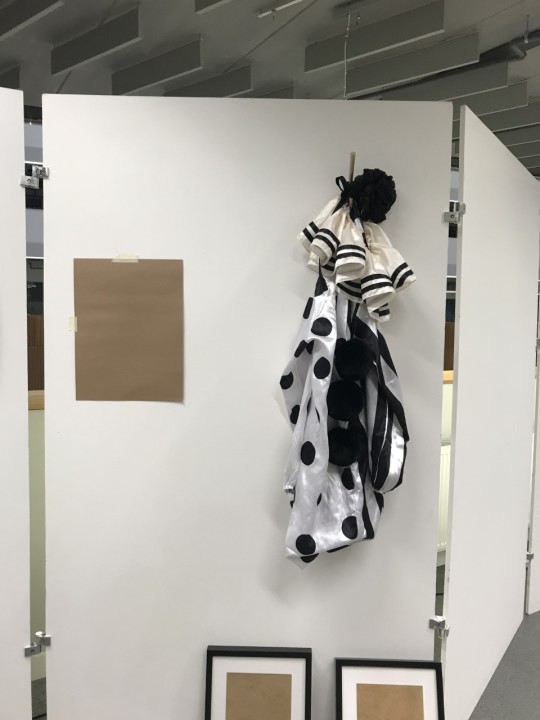
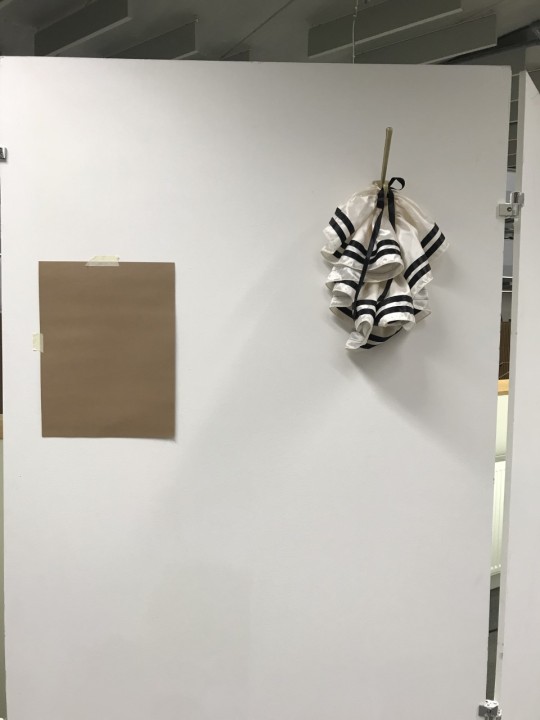
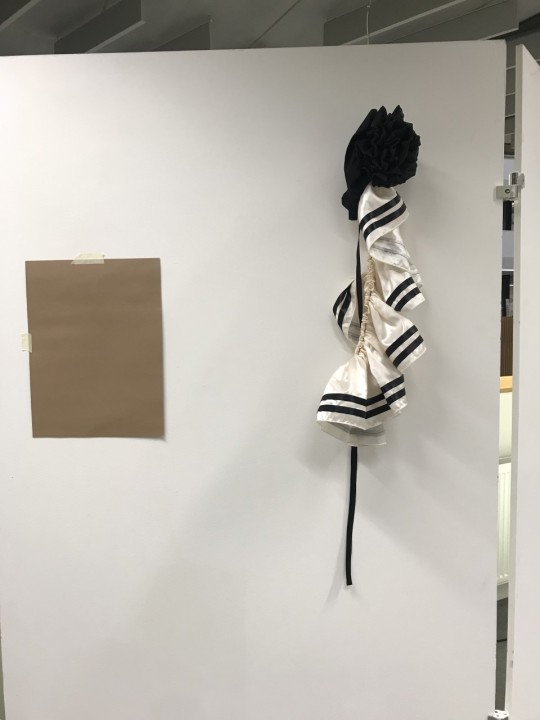
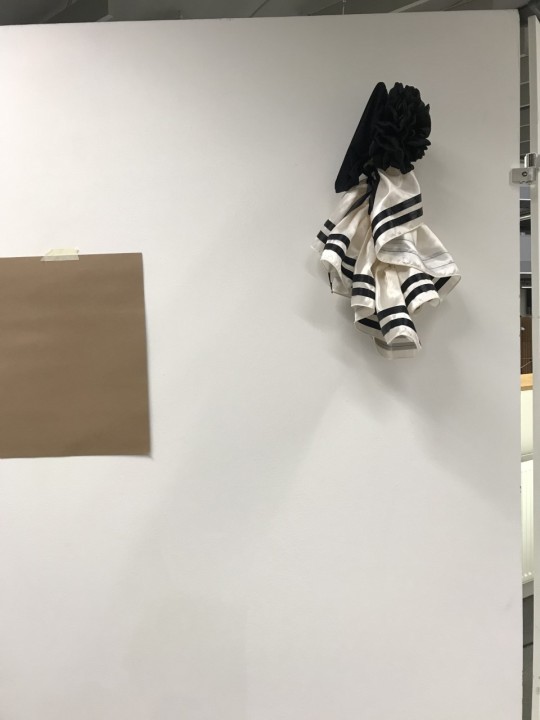


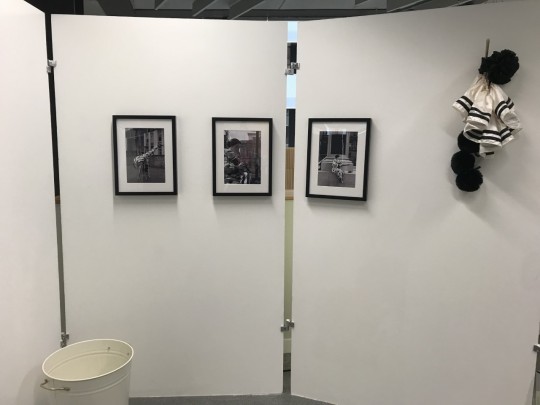

Different variations of the fabric manipulation using the costume. I decided upon the hat, collar and pom poms. The accessories alone prove the intention without the full suit needing to be present.
I also chose to frame the photographs as opposed to any other method of mounting. This is mostly to give them a formality and importance within the install. That this documentation is serious and neccessery.
0 notes
Photo


I also tested some of my found objects in the degree show space, but have decided against this as I want the focus to be mostly on my interpretations rather than photographs I did not create, but mostly used as research.



An aspect which I touched on previously was my collection of found objects, which I was using as both research for costuming purposes and a connection to tradition in performance.
However, another intention has become clear. While I am outcasting myself from the mainstream by performing as a clown, I am rejected, I now belong in this different sub-category of Pierrot performers.
This lays claim to an important point that when genuine and authentic towards your desires, you will always belong to a group or be wanted in specific ways, vulnerability will reap new connections. Mine is now to an innumerable amount of fellow clowns.
1 note
·
View note
Photo



An aspect which I touched on previously was my collection of found objects, which I was using as both research for costuming purposes and a connection to tradition in performance.
However, another intention has become clear. While I am outcasting myself from the mainstream by performing as a clown, I am rejected, I now belong in this different sub-category of Pierrot performers.
This lays claim to an important point that when genuine and authentic towards your desires, you will always belong to a group or be wanted in specific ways, vulnerability will reap new connections. Mine is now to an innumerable amount of fellow clowns.
1 note
·
View note
Text
The Trinity
As mentioned in the previous annotation, the project concerns three main ‘phases’; assimilation of the trees, asphyxiation of the wool and acceptance of the balloons.
This separation, three parts of one overarching narrative, is what links all of this work together so strongly despite differing aesthetics.
Assimilation: Representing a mind pre-occupied with acceptance and camouflage even if at the sacrifice of individuality or authenticity.
Asphyxiation: Representing anxiety-ridden states where self-perception and fear are rampant, but beginning to crack and release a genuine self.
Acceptance: Representing a liberated mind, one which realises rejection and all we fear will come with it is inevitable, and to revel in it removes its power.
Back to the three parts as well, I intend my degree show install to include three main ‘parts’. The balloons as a representation of performance itself as well as an action object, the photographs as mementos or snapshots of performance to infer a narrative, and the costume parts I created as a relic or prop from within the work with the actions recorded in its threads.
0 notes
Text
As I naturally want to include photographs as my recording, it felt like a logical next step to decide how many. relating back to the original brief, I feel a triptych would be the most visually striking.
It not only balances, but relates to the three separate ‘phases’ of my project; assimilation of the trees, asphyxiation of the wool and acceptance of the balloons.

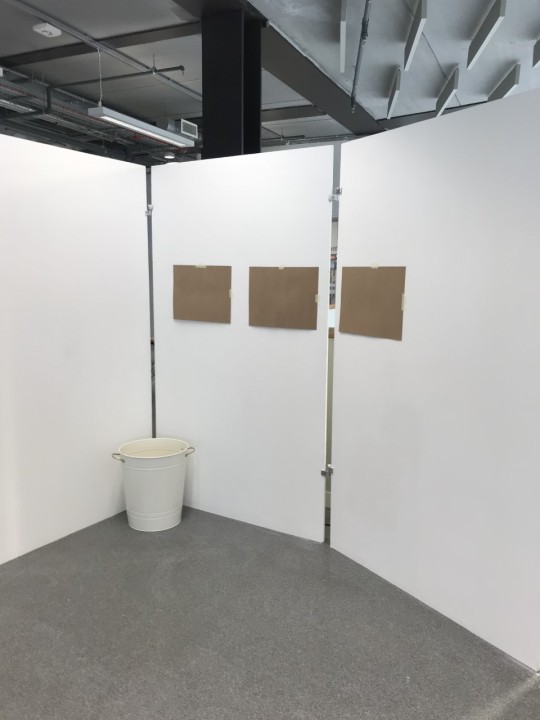

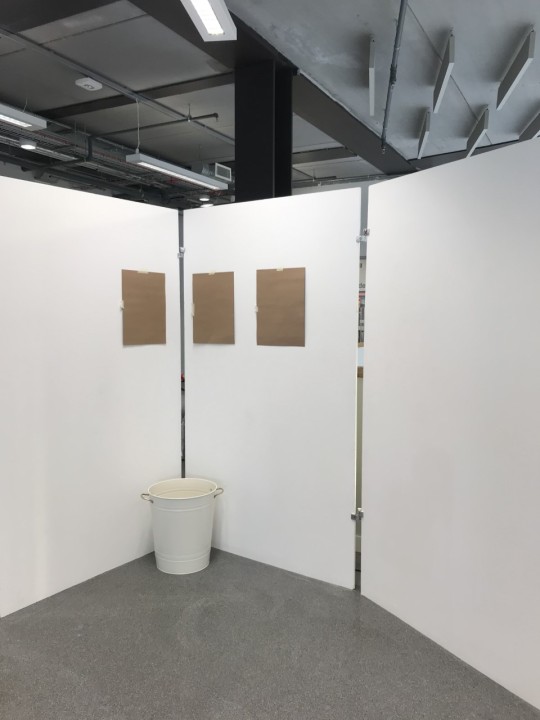
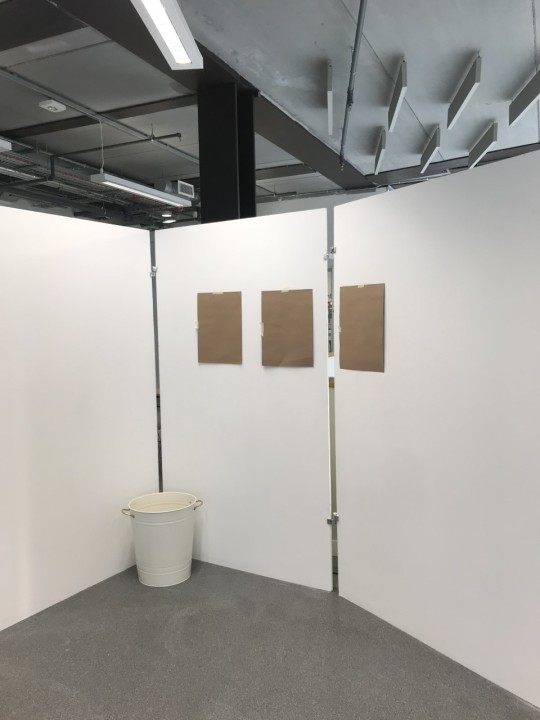
When assigned my space, I began by placing mockup pieces of paper in the correct size of my photographs to decide which layout is the most beneficial. I also have a receptacle in the corner that will be filled with balloons; the object part. They represent the deflating and transient nature of performance itself as well as an interactive aspect for viewers to unlock a freer or more childlike state of mind, without judgement.
0 notes
Text
Degree Show - Possibilities
My initial self-directed brief called for a recording of a performance to be shown as well as a triptych of sculptural items. As this development has went on, I have obviously found video a less necessary method of recording so it is likely photos will be my documentation within my install.
The use of object as recording and metaphor for the nature of performance has become a very integral part of my practice surrounding this work. So I believe it will be necessary for me to include objects within my install as a recording of the actions in their own right
0 notes
Text
Justifications
I chose to edit the photographs taken by Sophie into black and white as well as cropped and centred, minor touch ups.
The reason again for the monochrome is both aesthetic and conceptual. Aesthetically it aligns with the clown and minimal palette. Conceptually it allows the focus to be on form and action rather than distractions of colour.
The choice to photograph as my only method of documentation for this resolved work was very important. To use object alone to illustrate an action on the run up to my degree show may not suggest enough, but to show the whole sequence of events through audio or visual means may remove some of the curiosity. Photographing seems like a good compromise for my needs, to both show the actions undertaken but be like the plaster and clay tiles, a moment frozen in time as a stern recording of transient action.
0 notes
Photo


Recording of action, a small moment frozen. Where the performance becomes static, the decision to not use video for this performance is one I really stand by. To record performance in motion removes an aspect of imagination and curiosity, especially when trying to unlock childlike aspects of viewers and self.
0 notes

